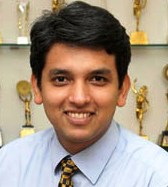
In an interview with Ruchika Chitravanshi, executive director Rakshit Desai says, while the company does offer high-end products, it also has products that are cheaper than competitors. Edited excerpts:
Thomas Cook has been in India for 129 years. How has it changed with the changing Indian consumer?
Thomas Cook came to India to take care of inbound British tourist arrivals. Now we take Indians to Britain. That's a historic change.
Of the four verticals you operate -- foreign exchange, leisure travel, corporate travel and insurance -- which has the highest share in terms of revenue and profit?
Revenue wise, it would be foreign exchange. Profit wise, it is difficult to ascertain. At present, foreign exchange is roughly two-thirds of our business.
In the next three to five years, the share of foreign exchange and travel in our revenue would be equal. Insurance is an interesting revenue strength but, in the grand scheme of things, it is the smallest.
It is a highly regulated product. We are basically playing in one segment, which is travel insurance.
What will be the key growth drivers for Thomas Cook this year?
The outbound side is looking very optimistic. Inbound has been a challenge as India, as a destination, became very expensive. So, foreign tourists haven't come as much.
But we are seeing some corrections in the market. So, inbound travel should pick up this year. Leisure travel is going to be the key driver for us. Corporate travel has not fully recovered but it is certainly much better than last year.
MICE (meetings, incentives, conferences and exhibitions), which is essentially a leisure product, also seems to be picking up.
Do you think that Thomas Cook has an image of a very high-end premium brand that makes you elusive to a larger customer base?
That has been a challenge. We are working on the brand perception. If there was any correction possible in a product, we have done it. We have been trying to address the issue of how to make ourselves more democratic.
We have associated with Golf, as well as the Mumbai Indians. If you do a data comparison, we are not so expensive.
Most of our bread and butter products are cheaper than the competitors.
On the positive side, we have a certain degree of quality associated with our name.
Are you excited by the opportunity presented by the Commonwealth Games?
We are quite excited. We hope it will drive a greater number of people to India and that rooms will be available. Last year, the cost of Indian travel experience went up so dramatically that it was difficult to sell India.
So, a spurt in the number of tourists is good, but the asset cost should not go up. It is a very small window. It
is kind of an off-season.
The number of inbound travellers in India is quite less, just the fact that you have so many athletes and their families and friends coming to India is an opportunity.
You recently launched your product Indulgence for high networth individuals. How big is the luxury travel segment for you?
It is significant, but not necessarily high in number. Average ticket value of a family of four -- going on an escorted group holiday -- is the same as buying a car.
For the luxury traveller, we frequently get honeymoons that cost Rs 20-30 lakh. They don't come from places like South Delhi or South Bombay but Thane, Indore, etc.
Compared to an international traveller, why is it that Indians travel for a much shorter duration?
There is a fragmentation of the travel purchase in India. First, it is prohibitively expensive and, second, a month is too long a period for a vacation. Nobody has that kind of time.
So, people are opting for multiple purchases through the year of shorter durations, whether international or domestic -- it doesn't matter.
So, I have a person who buys a package to Goa today and he would go to Bangkok for the next holiday for a week and then, probably six months down the line, he would take his family for a 15-day trip to Europe.
How has the profile of the typical Indian traveller changed?
There is no common profile. That is the beautiful part about the Indian market.
There are people who have worked for the Life Insurance Corporation of India all their lives and have made a substantial withdrawal from their provident fund to go for the journey of a lifetime.
At the same time, we get people who have just finished school or are just two years into college, who convince their parents for a backpacking trip to Europe. And, very often, they would be on the same coach.
How do you plan to be relevant as one entity to a vastly different consumer -- one fresh out of college and the other a retired senior citizen?
That is the challenge. Our customers are from two ends of the spectrum. They speak different languages, they have different value systems, they are also from very different parts of the country.
They transact and research in different ways. So, we do our own primary research as opposed to published data to get into the psyche of the customer.
What are some of the key findings of the research done by you?
One is the fragmentation of the travel purchase -- more frequent, shorter duration trips as against substantial summer holidays.
Earlier, if one had four holidays, then one would visit one's folks back home.
Now the change is that you would be looking for a getaway close by to unwind.
Youngsters have more disposable income, which they are willing to spend on travel and they are not guilty as it is their own hard-earned money.
Image: Rakshit Desai